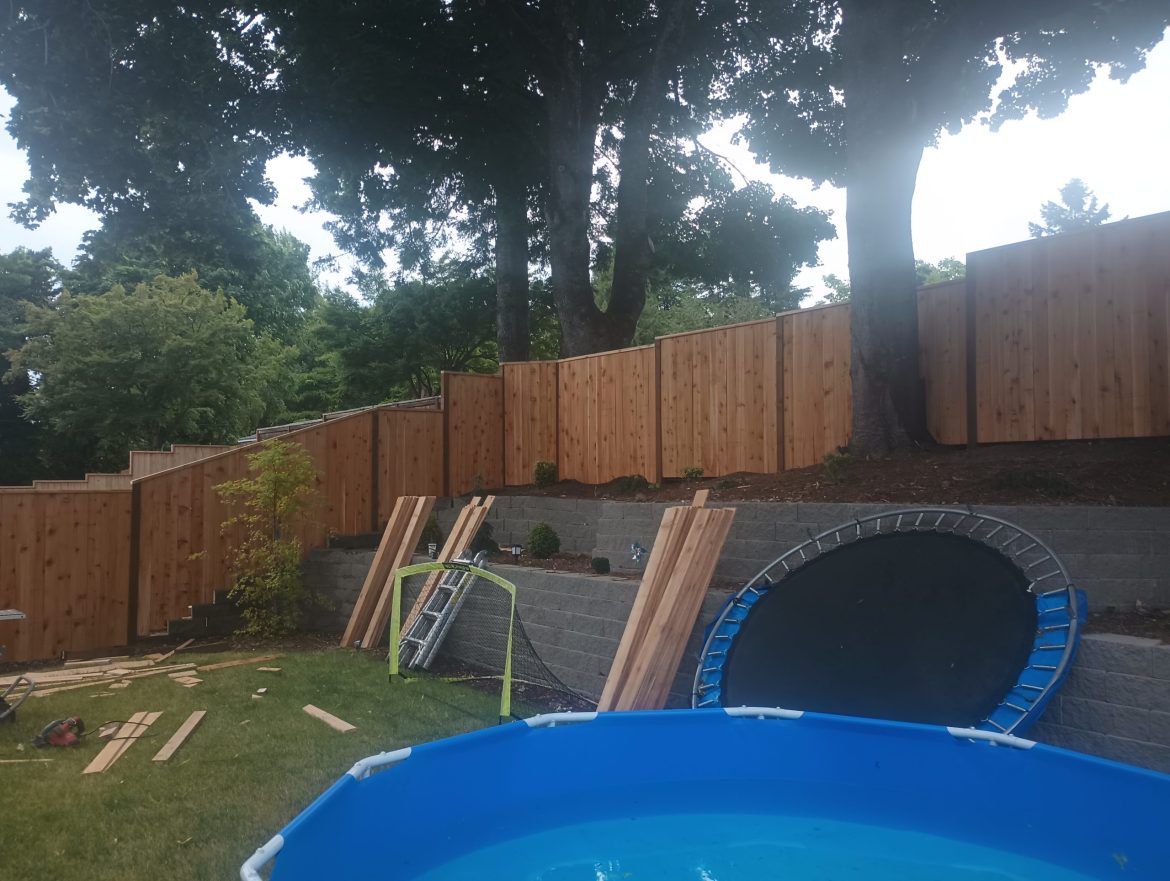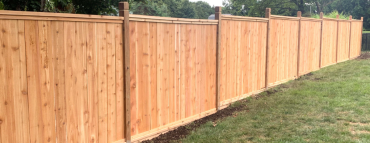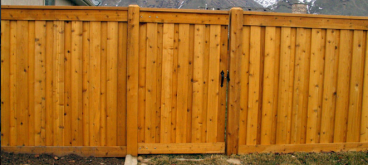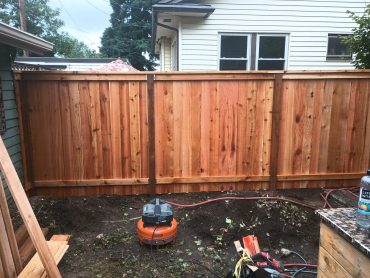Building a Fence on a Slope: A step by step Guide
Looking for a guide on how to build a fence on a slope? Or perhaps you crave some much-needed privacy while enjoying your outdoor space? If so, building a fence up a grade might be the perfect solution for you. But hold on! Before you grab that hammer and start nailing away, it’s crucial to understand the challenges that come with installing a fence on uneven ground.
Imagine this: You’ve carefully selected the height and style of your dream fence, only to realize that the sloped terrain poses unexpected hurdles. Fret not!
How to Build a Fence on Unlevel Ground
Throughout this article, we’ll discuss various techniques and methods that will help you successfully navigate the ups and downs of installing a fence up a grade. From understanding how different materials adapt to slopes to discovering practical examples of well-executed projects, we’ve got you covered.
But first things first – planning is key! We’ll emphasize the importance of proper preparation and guide you through essential considerations for designing your fence on sloped terrain. By adopting the right strategies from the get-go, you can save yourself time, money, and frustration down the line.
So, if you’re ready to take your privacy game to new heights (pun intended), let’s dive in and uncover everything you need to know about building a fence up a grade!

Understanding the Risks of Uneven Fencing and Considering Racked Fencing:
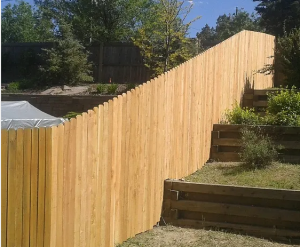
Uneven fencing can present a multitude of problems that may compromise both the functionality and aesthetics of your fence. Gaps between panels, instability, and an overall unappealing appearance are just a few potential issues you may encounter. Fortunately, there is a solution to overcome these challenges – racked fencing.
Racked fencing refers to the installation technique used to accommodate sloped or graded areas. Unlike traditional fences that are installed parallel to the ground, racked fences are designed to follow the contour of the land. This method ensures that your fence remains level and visually appealing, even on uneven terrain.
One significant advantage of using racked fencing is its ability to adapt to grade changes. When dealing with slopes, it can be challenging to maintain a consistent height for each panel in a traditional fence. As a result, gaps may form at the bottom or top of the fence, compromising security and privacy. Racked fences eliminate this problem by allowing for seamless transitions along the slope while maintaining a uniform height throughout.
The Best Solution to fencing up on up or down a grade
In addition to addressing height discrepancies, racked fencing also helps maintain stability in uneven areas. Traditional fences installed on sloped ground often struggle with structural integrity due to uneven pressure distribution. This can lead to leaning or even collapse over time. Racked fences distribute weight more evenly across each panel, reducing strain on individual sections and ensuring long-term durability.
Beyond their practical benefits, racked fences offer aesthetic advantages as well. By following the natural contours of the land, these fences create an attractive flow that seamlessly integrates with your landscape design. Whether your property features gentle slopes or steep inclines, racked fencing allows you to build a visually pleasing fence line without sacrificing functionality.
To further illustrate how effective racked fencing can be when dealing with grade changes, consider this scenario: Imagine you have a backyard that slopes downward towards one corner. Without racked fencing, installing a traditional fence would result in a series of stepped panels that disrupt the flow of your yard. However, by opting for racked fencing, you can create a smooth and continuous fence line that complements the natural slope. This not only enhances the overall appearance but also ensures that your fence serves its purpose effectively.
Different Types of Fences for Various Slopes
Overview of Fence Types Suitable for Sloped Yards
It’s important to choose the right fence type that can adapt to the slope of your yard. There are several options available, including vinyl, wood, and chain-link fences. Each type has its own advantages and disadvantages.
Vinyl Fences: These fences are known for their durability and low maintenance. They come in a wide range of styles and designs, making them suitable for various slopes. Vinyl fence panels can be easily adjusted to accommodate small dips or uneven slopes. The flexibility of vinyl material allows you to contour the fence line smoothly along the slope, ensuring a seamless look.
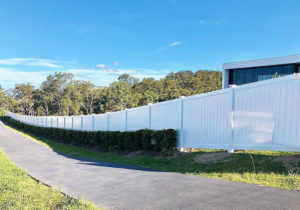
Wooden Fences: Wood is a popular choice for many homeowners due to its natural beauty and versatility. When building a wooden fence on steep slopes, it’s essential to choose the right design that can handle the incline effectively. One option is a stepped fence design, where each panel is installed horizontally but at different heights. This creates an even appearance while following the contour of the slope.
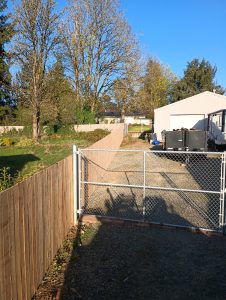
Chain-Link Fences: Chain-link fences are commonly used for security purposes and are also suitable for sloped yards. The mesh-like structure allows them to adapt easily to varying degrees of slope. By adjusting tension wires and using appropriate posts, chain-link fences can be installed on both gentle and steep slopes without compromising their integrity.
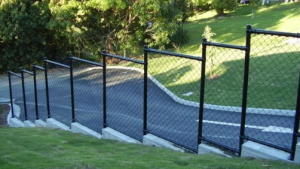
Factors to Consider When Choosing Fence Type Based on Slope Severity
When deciding which type of fence will work best for your sloped yard, there are several factors you should consider:
-
Slope Steepness: The severity of the slope will play a significant role in determining which type of fence is most suitable. Steeper slopes may require more specialized installation techniques or specific types of fencing materials.
-
Budget: Different fence types come with varying costs. It’s essential to consider your budget when choosing the right fence for your sloped yard. While vinyl fences may be more expensive initially, their low maintenance and long lifespan can make them a cost-effective option in the long run.
-
Aesthetics: The appearance of the fence is another crucial factor to consider. You want a fence that not only serves its purpose but also complements the overall look of your property. Wood fences are often preferred for their natural beauty, while vinyl and chain-link fences offer a more modern and sleek appearance.
-
Durability: Consider how well the chosen fence type will withstand the elements and potential wear and tear over time. Vinyl fences are known for their durability and resistance to rot, whereas wood fences may require regular maintenance such as staining or painting.
Examples Showcasing Effective Use of Different Fences on Various Slopes
To better understand how different fence types can be used effectively on various slopes, let’s take a look at some examples:
-
Vinyl Fence on an Even Slope: Imagine a gently sloping yard where you want to install a vinyl privacy fence. With its flexibility, vinyl panels can easily follow the contour of the slope without any abrupt changes in height or design. This ensures a seamless transition from one section of the fence to another, creating an aesthetically pleasing result.
-
Wooden Stepped Fence on Steep Slopes: In cases where you have steep slopes, a stepped wooden fence design works best. By installing each panel horizontally but at different heights, you create an even appearance while allowing the fence to adapt to the incline smoothly.
-
Chain-Link Fence on Small Dips: If your yard has small dips or irregularities along its slope, chain-link fences are ideal due to their flexibility and adjustability. The mesh structure allows the fence to accommodate these small variations without compromising its integrity.
Tips and Solutions for Installing a Fence on Uneven Ground
Importance of Accurate Measurements and Surveying
Before diving into the installation process, it is crucial to emphasize the significance of accurate measurements and thorough surveying. Uneven ground presents unique challenges that can impact the stability and overall effectiveness of your fence. By taking precise measurements and conducting a detailed survey, you can ensure that your fence will be properly installed, providing both security and aesthetic appeal.
To begin, measure the length of the area where you plan to install the fence. Use a measuring tape or laser level to determine any variations in height along the perimeter. This will help you identify uneven spots and assess how much adjustment is needed during installation.
Next, conduct a thorough survey of the terrain. Look out for any potential obstacles such as tree roots, large rocks, or underground utilities that may interfere with your installation process. Identifying these obstacles beforehand will save you time and effort later on.
Techniques for Leveling Posts on Uneven Terrain
One common challenge when installing a fence on uneven ground is ensuring that the posts are level. Properly leveled posts are essential for maintaining structural integrity throughout your fence line.
There are two primary techniques for leveling posts on uneven terrain: using concrete or gravel.
-
Concrete: When dealing with significant grade changes, using concrete is recommended to provide maximum stability. Dig holes for each post according to your measurements, making sure they are deep enough to accommodate at least one-third of each post’s length. Place the post in position and brace it temporarily with stakes or clamps.
Mix concrete according to the manufacturer’s instructions and pour it into each hole around the post until it reaches ground level. While pouring, use a level to ensure that each post remains plumb (vertically straight). Allow sufficient time for the concrete to cure before moving forward with attaching panels or rails.
-
Gravel: If minor adjustments are needed to level the posts, using gravel can be a more convenient option. Dig holes for each post as before, but this time make them slightly wider and shallower. Place the post in position and stabilize it temporarily.
Fill each hole with gravel up to ground level, ensuring that the post remains plumb throughout the process. Compact the gravel by tamping it down firmly. This method provides stability while allowing for easier adjustments if necessary.
Utilizing Adjustable Brackets or Stepped Panels
To accommodate slope changes on uneven ground, adjustable brackets or stepped panels can be utilized during fence installation. These solutions offer flexibility and ensure a seamless transition along your property line.
-
Adjustable Brackets: Adjustable brackets are designed specifically for fencing on uneven terrain. They allow you to pivot each panel separately, accommodating changes in slope without compromising the overall integrity of your fence.
Install the brackets at appropriate intervals along your fence line, following manufacturer instructions. Attach each panel to its respective bracket and adjust accordingly to create a smooth alignment from one section to another.
-
Stepped Panels: Another effective solution is using stepped panels. This technique involves installing panels at varying heights to follow the natural contour of the ground.
Start by determining the height difference between each step based on your measurements and surveying results. Begin installing panels from the highest point downwards, adjusting their positions according to the slope until you reach flat ground again.
Addressing Common Challenges like Soil Erosion Control
During fence installation on uneven ground, it is essential to address common challenges such as soil erosion control. Uneven terrain often exacerbates issues related to water runoff and soil displacement, which can affect both your fence’s stability and surrounding landscape.
To tackle soil erosion effectively:
-
Grading: Prioritize proper grading techniques by leveling out any excessively steep areas that may contribute to erosion problems. Level Ground will allow you to easily build a fence without cutting several boards.
-
Drainage Solutions: Consider implementing drainage solutions, such as French drains or swales, to redirect water away from your fence line and prevent soil erosion.
-
Landscaping: Incorporate appropriate landscaping elements like retaining walls or terraces to help stabilize the soil and minimize erosion risks.
By addressing these challenges head-on, you can ensure that your fence installation on uneven ground is not only structurally sound but also environmentally conscious.
Techniques for Building a Fence on Uneven Terrain
Building a fence on uneven terrain can be a challenging task, but with the right techniques and tools, it is definitely achievable. Whether you are dealing with a gentle slope or a steep incline, these step-by-step guidelines will help you install a fence that follows the natural contour of the land while providing security and privacy.
Digging Appropriate Post Holes at Varying Depths
The first step in building a fence on uneven terrain is to dig post holes at varying depths based on the slope gradient. Start by marking the locations for your fence posts along the desired line. Use stakes and string lines to ensure accuracy.
When digging the post holes, it’s important to consider the contour of the land. For steeper slopes, you may need to dig deeper holes on one side and shallower holes on the other to maintain an even height for your fence panels. This technique is known as a stepped fence.
To make sure your posts are securely anchored, use a hole digger or post hole auger appropriate for your soil type. The depth of each hole should be below the frost line in your area for stability.
Aligning Posts Vertically Using String Lines or Levels
Once all the post holes are dug, it’s time to align them vertically. This can be done using string lines or levels. Attach strings between two end posts at both top and bottom heights to create guide lines for aligning intermediate posts.
Alternatively, you can use a level against each post individually to ensure they are perfectly vertical. Adjustments may be necessary by adding or removing soil from beneath each post until they are aligned correctly.
Adjusting Panel Heights Accordingly to Follow the Natural Contour
One of the key aspects of building a fence on uneven terrain is adjusting panel heights according to follow the natural contour of the land. As mentioned earlier, this can be achieved through stepped fencing, where the panels are installed at different heights to accommodate the slope.
Start by installing the lowest panel at the highest point of the slope. As you continue, gradually adjust the height of each panel to match the contour of the land. This will help prevent unsightly gaps between panels and ensure a visually appealing fence.
Securing Panels Firmly While Maintaining Proper Alignment
Securing fence panels firmly is crucial for their longevity and stability. Use gravel or concrete to secure each post in its respective hole. Fill the hole with gravel up to a few inches below ground level, compacting it as you go. Alternatively, pour concrete into each hole and allow it to set according to manufacturer instructions.
Once your posts are securely anchored, attach the fence panels using appropriate hardware such as screws or nails. Make sure they are aligned properly by using a level or string lines for reference.
To maintain proper alignment throughout the installation process, periodically check that each panel is level and adjust if necessary. This will ensure a straight and aesthetically pleasing fence that follows the natural contour of your sloping terrain.
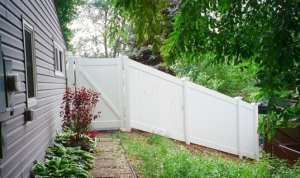
Choosing the Best Fence Type for a Sloped Yard:
There are several factors to consider. Evaluating your budget, desired aesthetics, maintenance requirements, and privacy needs is crucial in making the right choice. It’s important to think about how different fence materials adapt to sloped terrain and their suitability based on slope severity and local climate conditions. While consulting with professionals is always recommended for expert advice, let’s explore some options that you can consider when building a fence up a grade.
Vinyl Fence: A Versatile Option
Vinyl fences have gained popularity in recent years due to their versatility and low maintenance requirements. They offer an excellent solution for sloped yards as they can be easily adapted to uneven terrains without compromising their structural integrity. Vinyl fences come in various styles and colors, allowing you to choose an option that matches your desired aesthetics.
One of the advantages of vinyl fences is their durability. They are resistant to rotting, warping, and insect damage, making them suitable for areas with diverse weather conditions. Vinyl fences require minimal upkeep compared to other materials such as wood or metal. With occasional cleaning using mild soap and water, your vinyl fence will retain its appearance for years to come.
Another benefit of vinyl fences is their cost-effectiveness. While the initial installation may be slightly more expensive than other options like wood fences, the long-term savings on maintenance make them an attractive choice for many homeowners. Furthermore, vinyl fences offer excellent privacy due to their solid construction and lack of gaps between panels.
Terraced Garden Fencing Ideas for Sloped Yards:
Are you struggling with how to build a fence up a grade in your sloped yard? Look no further! By showcasing various landscaping techniques that integrate fences into tiered garden designs, we’ll provide you with inspiration and practical solutions to make the most of your outdoor space.
Exploring Creative Options: Terraced Gardens
When faced with the challenge of building a fence on a sloped lawn, consider incorporating terraced gardens into your design. Terracing involves creating multiple levels or tiers on the slope, which not only adds visual interest but also provides functional benefits. By leveraging the natural contours of your yard, you can create stunning vertical gardens while ensuring the stability of your fence.
Terracing offers several advantages for sloped yards. Firstly, it improves aesthetics by transforming an otherwise challenging landscape into an eye-catching feature. With each tier serving as a mini-garden bed, you have the opportunity to showcase different plants and flowers, adding color and texture to your outdoor space. Terracing helps control soil erosion by preventing water runoff and allowing it to be absorbed gradually through each level.
Landscaping Techniques: Integrating Fences into Tiered Garden Designs
To successfully integrate fences into tiered garden designs, there are various landscaping techniques you can employ. Here are some ideas to get you started:
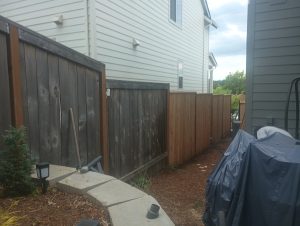
-
Stepped Fence: Install a stepped fence that follows the contour of each terrace level. This creates a seamless transition between the garden beds and provides structural support for both the fence and the terraces.
-
Retaining Walls: Consider using retaining walls as part of your terraced garden design. These walls not only help define each level but also offer additional support for your fence while preventing soil erosion.
-
Living Fences: Instead of traditional wooden or metal fences, explore the concept of living fences. Planting tall shrubs or dense hedges along the terraced levels can serve as a natural and visually appealing boundary.
-
Vertical Garden Fence: Combine the functionality of a fence with the beauty of a vertical garden by incorporating planter boxes or trellises into your fence structure. This allows you to grow climbing plants or vines that will add greenery and charm to your terraced garden.
Inspiration through Successful Projects
To further inspire your own terraced garden fencing project, let’s take a look at some successful examples:
-
Example 1: John transformed his sloped yard into an enchanting outdoor oasis by building stone retaining walls at each level. He then installed a cedar stepped fence that perfectly complemented the natural elements of his terraced garden.
-
Example 2: Sarah opted for a combination of living fences and vertical gardens in her tiered yard design. By planting evergreen shrubs along the edges and incorporating trellises into her fence, she achieved both privacy and lush greenery throughout her outdoor space.
-
Example 3: Mark embraced a contemporary approach by using sleek metal panels for his terraced garden fencing. The clean lines and modern design added an elegant touch to his sloped lawn while providing stability and security.
Remember, when building a fence up a grade in your sloped yard, it’s essential to consider not only practicality but also aesthetics. Terracing offers an excellent solution by blending landscaping techniques with functional fencing, resulting in an inviting outdoor space that makes the most of your unique landscape.
So why wait? Get started on transforming your sloped yard into a stunning terraced garden today!
Note: The above content is written in adherence to the guidelines provided.
Mastering the Art of Building a Fence Up a Grade:
Building a fence up a grade can be a challenging task that requires patience, precision, and the right tools. Whether you are working with wood, metal, or custom fencing options like wrought iron, it is essential to follow proper techniques to ensure a sturdy and durable fence.
Emphasizing the Need for Patience, Precision, and Proper Tools
One cannot underestimate the importance of patience. Rushing through the installation process can lead to mistakes that compromise the overall stability and longevity of your fence. Take your time to plan each step carefully and execute them with precision.
To achieve accurate measurements and alignment throughout the process, invest in quality measuring tools such as levels and tape measures. These tools will help you ensure that your fence is level and properly aligned even on uneven terrain. Remember that small discrepancies in measurements can accumulate over longer stretches of fencing, so attention to detail is crucial.
Tips for Ensuring Accurate Measurements and Alignment
-
Begin by surveying the area where you intend to build your fence. Look for any significant variations in ground elevation or potential obstacles that may affect your installation.
-
Use stakes or markers at regular intervals along the proposed fence line to establish reference points for measurement.
-
Measure the distance between each stake using a tape measure or laser level tool. This will help you determine how much slope adjustment is needed between posts.
-
Adjust post height accordingly by cutting them at different lengths if necessary. Ensure that each post remains plumb (vertical) while accommodating changes in ground elevation.
-
For wooden panels or picket fences, consider installing stepped panels where each section follows the contour of the slope while maintaining level tops.
-
When installing rail fences or retaining walls, use brackets or hardware designed for sloping ground to maintain proper alignment.
Techniques for Securely Anchoring Posts on Sloping Ground
One of the most critical aspects of building a fence up a grade is securely anchoring the posts. Depending on your preference and budget, you can choose between using concrete or alternative methods to ensure stability.
If you opt for concrete, follow these steps:
-
Dig post holes at least one-third the height of each post and wider than the diameter of the post itself.
-
Place a few inches of gravel at the bottom of each hole to improve drainage.
-
Set each post in its respective hole and brace it in position using temporary supports.
-
Mix concrete according to manufacturer instructions and pour it into each hole around the post until it reaches ground level.
-
Use a level to ensure that each post remains plumb while the concrete sets. Adjust as necessary before it hardens completely.
Alternatively, if you prefer not to use concrete, other methods such as earth anchors or helical piles can provide adequate support while minimizing excavation work.
Importance of Regular Maintenance for Long-Lasting Durability
Once your fence is successfully installed on sloping ground, regular maintenance becomes crucial in ensuring its long-lasting durability. Here are some essential tips:
-
Inspect your fence periodically for any signs of damage or wear.
-
Repair or replace any broken pickets, rails, or sections promptly.
-
Check posts regularly to ensure they remain stable and secure.
-
Keep vegetation trimmed away from the fence line to prevent moisture buildup and potential damage.
-
Apply protective coatings or sealants as recommended by manufacturers to enhance longevity.
-
Clean your fence regularly with mild soap and water to remove dirt and debris that may cause deterioration over time.
By following these maintenance practices consistently, you can extend the lifespan of your fence and keep it looking great for years to come.
Building a fence up a grade may present its fair share of challenges, but with the right techniques and attention to detail, it can be a rewarding endeavor. Remember to prioritize patience, precision, and proper tools throughout the installation process.
Frequently Asked Questions about Fences on Slopes:
Common Concerns Addressed
Installing a fence on uneven terrain can be a daunting task, but with the right knowledge and approach, it is definitely achievable. Here are some common concerns people have regarding building fences up a grade:
-
Will the fence be stable on a slope?
-
Yes, it is possible to build a stable fence on a slope. The key lies in properly anchoring the posts and ensuring they are set at appropriate intervals. By using longer posts and adjusting their depth according to the slope, you can ensure stability.
-
-
How do I determine property boundaries when dealing with slopes?
-
When installing a fence on sloped land, it’s crucial to accurately determine your property boundaries beforehand. You can consult your property survey or hire a professional surveyor to mark the boundaries for you. This will help avoid any disputes with neighbors down the line.
-
-
Do I need permits for building a fence on uneven terrain?
-
Permit requirements vary depending on your location and local regulations. It’s important to check with your local government or building department to understand if permits are necessary for constructing fences on slopes in your area.
-
-
Are there any legal considerations I should be aware of?
-
Legal considerations may come into play when building fences up slopes, particularly if there are specific zoning restrictions or homeowner association rules in place. Familiarize yourself with these regulations to ensure compliance and avoid potential issues later.
-
Solutions to Potential Issues
Building a fence up a grade comes with its own set of challenges, but there are solutions available for common issues that may arise:
-
Water Runoff:
-
One concern when installing fences on slopes is water runoff that can accumulate near the base of the fence during heavy rains. To address this issue, consider incorporating drainage solutions such as French drains or swales to redirect water away from the fence line.
-
-
Access Points:
-
Another consideration is providing access points along a sloped fence line, especially if you have a large property or need to accommodate maintenance equipment. Installing gates strategically at different levels can make it easier to navigate the slope and access various areas of your property.
-
Choosing Contractors or DIY Approaches
Deciding whether to hire a professional contractor or take on the project yourself depends on your individual circumstances. Here are some factors to consider:
-
Complexity of the Project:
-
If you have little experience with construction projects, tackling a fence installation on uneven terrain might be challenging. In such cases, hiring a professional contractor who specializes in building fences on slopes can ensure a smoother process and better results.
-
-
Budget Constraints:
-
DIY approaches can save money, but they require time, effort, and skill. If you’re working with a tight budget and have confidence in your abilities, taking the DIY route might be feasible. However, keep in mind that mistakes could end up costing more in the long run.
-
-
Time Constraints:
-
Building a fence up a grade can be time-consuming, especially if you’re juggling other commitments. Hiring professionals allows you to focus on other tasks while they handle the installation efficiently.
-
-
Safety Considerations:
-
Construction work involves potential hazards, so it’s important to assess your comfort level with safety precautions and equipment before deciding between DIY or hiring professionals.
-
Remember that regardless of which approach you choose, thorough research and planning are crucial for successful fence installation on slopes.
Installing Fences on Slopes: Parallel, Racked, and Cost Considerations (Continued):
Comparing parallel vs. racked installations in terms of cost-effectiveness and visual appeal
There are two main installation methods to consider: parallel and racked. Each method has its own advantages and drawbacks, so it’s important to weigh the options before making a decision.
-
Parallel Installations: In a parallel installation, the rails of the fence run horizontally along the slope, while the panels remain vertical. This method is often more cost-effective since it requires fewer materials compared to racked installations. Parallel fences can provide a visually appealing look that complements the natural slope of your landscape.
-
Racked Installations: On the other hand, racked installations involve adjusting each panel individually to follow the contour of the slope. While this method may require more materials due to the angled positioning of the panels, it offers greater flexibility in accommodating steeper slopes. Racked fences can create a seamless appearance by following the natural flow of your land.
In terms of cost-effectiveness and visual appeal, both methods have their merits. If you’re working with a tighter budget or have a moderate slope on your property, a parallel installation might be your best bet. However, if you have steep terrain or prioritize achieving an aesthetically pleasing look that seamlessly integrates with your landscape’s contours, then opting for a racked installation could be worth considering.
Discussing factors that influence material requirements and overall project expenses
When planning to build a fence up a grade, several factors come into play that can impact both material requirements and overall project expenses:
-
Slope Gradient: The steepness of your slope will heavily influence how much material you’ll need for your fence installation. A higher gradient will require more panels and rails for either method.
-
Fence Height: The height of your fence is another crucial factor to consider. Taller fences may require additional reinforcement and support, which can increase material costs.
-
Soil Conditions: The type and stability of the soil on your slope will affect the installation process. If the soil is loose or prone to erosion, extra measures may be necessary to ensure the fence’s durability, potentially adding to project expenses.
-
Access to Site: The accessibility of your site can impact both material delivery and installation efficiency. Difficult-to-reach areas might require additional labor or equipment, leading to increased costs.
By taking these factors into account during the planning phase, you can estimate your material requirements more accurately and avoid unexpected expenses down the line.
Weighing pros and cons to help readers make informed decisions about their specific needs
When deciding between a parallel or racked installation for your fence on a slope, it’s essential to consider the pros and cons associated with each method:
Parallel Installations:
Pros:
-
Cost-effective due to fewer materials required
-
Provides a clean and symmetrical look
-
Easier installation process compared to racked installations
Cons:
-
Limited suitability for steeper slopes
-
May not follow the natural contours of the land as well as racked installations
Racked Installations:
Pros:
-
Adaptable for various slope gradients
-
Offers a seamless appearance that follows the natural flow of the landscape
-
Can enhance visual appeal in hilly terrains
Cons:
-
Requires more materials than parallel installations
-
Installation process may be more time-consuming and complex
By weighing these pros and cons against your specific needs, you can make an informed decision that aligns with both your budgetary constraints and aesthetic preferences.
Highlighting additional considerations like maintenance costs over time
Beyond initial installation considerations, it is important to think about long-term maintenance costs when building a fence up a grade. Factors to keep in mind include:
-
Material Durability: Choosing high-quality materials that can withstand the elements is crucial. While initial costs may be higher, investing in durable materials can save you money on repairs and replacements in the long run.
-
Weather Exposure: The exposure of your fence to weather conditions like heavy rain, strong winds, or extreme temperatures can impact its longevity. Consider the specific climate of your area when selecting materials and factor in potential maintenance needs accordingly.
-
Regular Inspections: Conducting routine inspections of your fence will help identify any issues early on. Promptly addressing minor damages or wear and tear can prevent more significant problems down the line and potentially save you money on extensive repairs.
-
Staining or Painting: Depending on the material chosen for your fence, regular staining or painting may be necessary to maintain its appearance and protect it from moisture damage. Consider the associated costs when budgeting for long-term maintenance.
Conclusion:
Creating a Level-Topped Fence with Proper Post Cutting (Continued):
In order to build a fence up a grade, it is crucial to understand the risks of uneven fencing and consider using racked fencing. Uneven ground can pose challenges during installation, but there are various types of fences available for different slopes. By following some tips and solutions, you can successfully install a fence on uneven terrain.
Building a fence on sloped yards requires specific techniques that ensure stability and durability. It is important to choose the best fence type that suits your needs and complements the slope of your yard. Terraced garden fencing ideas can also be explored for sloped yards, adding an aesthetic touch to the overall landscape.
Mastering the art of building a fence up a grade may seem daunting at first, but with proper planning and execution, it can be achieved. By considering factors such as parallel or racked installation methods and cost considerations, you can make informed decisions throughout the process.
To further assist you in your journey of installing fences on slopes, here are some frequently asked questions:
FAQs:
Q: Can I install any type of fence on uneven ground?
A: While many types of fences are suitable for uneven ground, certain designs like rackable or stepped fences are specifically designed to accommodate slopes effectively.
Q: How do I determine if my yard has significant slope?
A: You can use a level or other measuring tools to assess the degree of slope in your yard. If there is more than a slight incline, special considerations will need to be made during fence installation.
Q: What are some cost considerations when building a fence up a grade?
A: Building on uneven terrain may require additional materials or labor compared to flat ground installations. It’s important to budget accordingly and obtain quotes from professionals if needed.
Q: Are there any regulations or permits I need to consider when building a fence?
A: Depending on your location, there may be specific regulations or permits required for fence installation. It is advisable to check with local authorities to ensure compliance.
Q: Can I install a fence on a steep slope?
A: While it is possible to install a fence on a steep slope, it may require more advanced techniques and additional support structures. Consulting with professionals can help determine the best approach.
Remember, building a fence up a grade requires careful planning and execution. By considering the unique challenges of uneven ground and selecting appropriate methods and materials, you can successfully create a level-topped fence that enhances both the functionality and aesthetics of your property.
Now that you have learned about the different aspects of building fences on slopes, it’s time to put your knowledge into action. Start planning your project today and enjoy the benefits of an expertly installed fence that adds value to your property while providing privacy and security.
FAQs:
Q: How deep should I dig the post holes for my fence?
A: The depth of post holes depends on various factors such as soil conditions, height of the fence, and local regulations. As a general guideline, aim for at least one-third of the total post length buried in the ground.
Q: What materials are commonly used for fencing on slopes?
A: Common materials for fencing on slopes include wood, vinyl, aluminum, or composite materials. Each has its own advantages in terms of durability, maintenance requirements, and aesthetic appeal.
Q: Can I install a gate on an uneven slope?
A: Yes, gates can be installed on uneven slopes by using adjustable hinges or adding additional support structures to ensure proper operation.
Q: How do I maintain my sloped yard once the fence is installed?
A: Regular maintenance practices such as mowing grass or trimming vegetation along the fence line will help keep your sloped yard tidy. Inspecting the fence periodically for any damage or loose components is recommended.
Q: Can I install a fence myself or should I hire a professional?
A: The decision to install a fence yourself or hire a professional depends on your level of experience, available time, and the complexity of the project. If you are unsure about any aspect of the installation process, it is advisable to seek professional assistance.
Looking for Christmas Light Installation in Portland, Oregon

